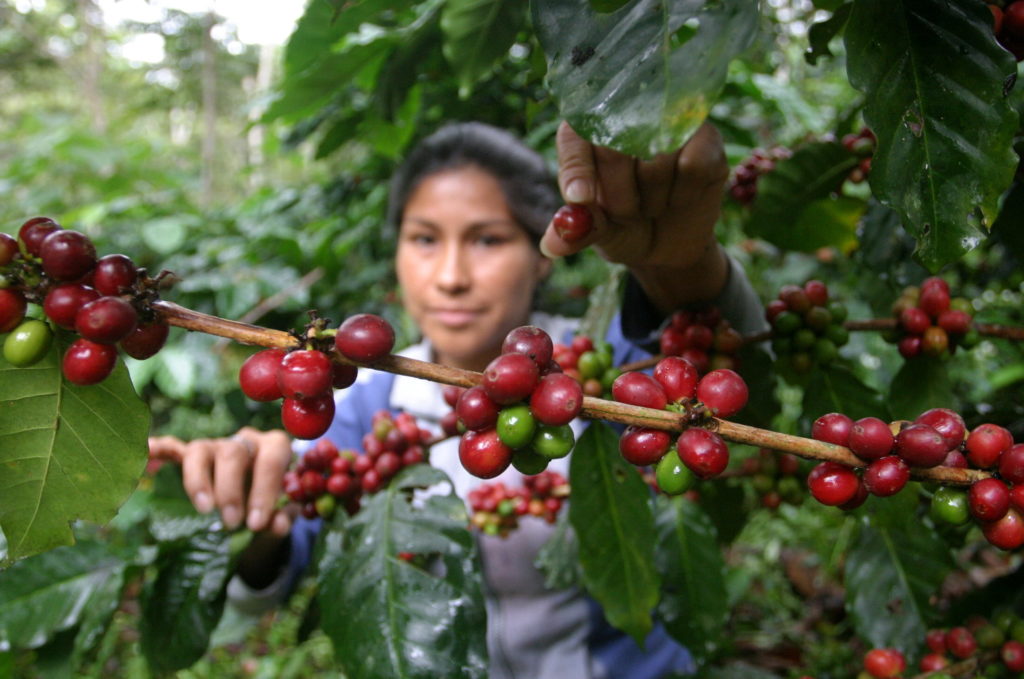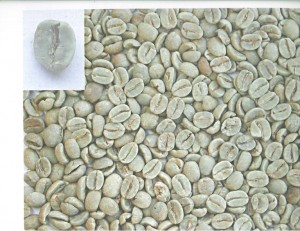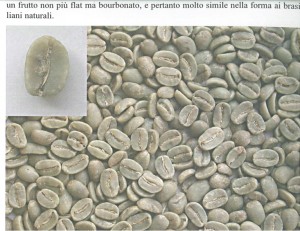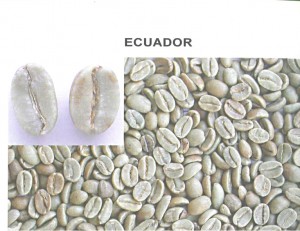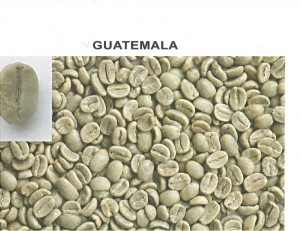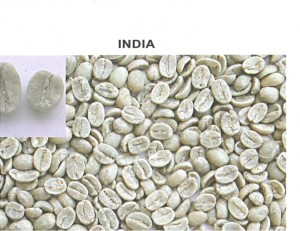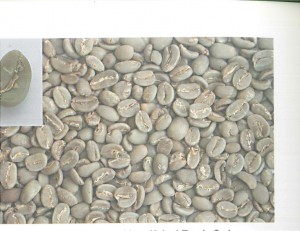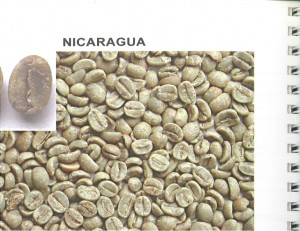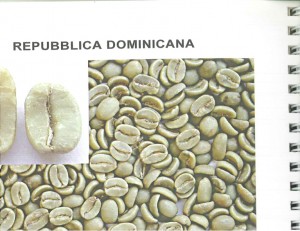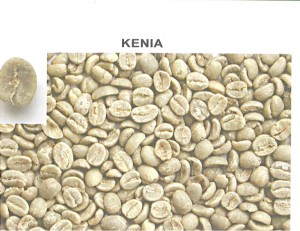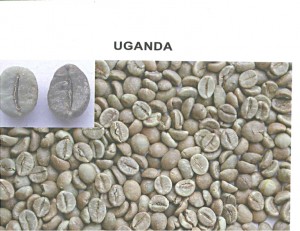RAW COFFEE: ORIGIN AND CLASSIFICATIONS
Complete guide for the coffee enthusiast
The green coffee according to their botanical varieties are distinguished, for what we are interested in two major varieties: RUGGED and ARABIAN .
• The coffee STRONG , raw, are presented in rounded grains, full, very hard, color sometimes greenish-yellow-brownish. In the roasting have a certain resistance to cooking , precisely because of their hardness, the roasted color is not uniform, often arlecchinato. In the cup, they give a flavor not very stressed, almost neutral, while the infusion is dark with a thick foaming .
• The coffee ARABICA present themselves to grains with an oval side and the other paved (flatbean), are particularly soft color light green / bluish or silvery green. Less resistant to cooking, roasted color mostly homogeneous. Depending on their origin, they have many different organoleptic characteristics (taste and odor).
The BRAZIL origin coffee mug to make a thick taste of sweetness even if the color is clear. The origin coffee CENTRAL AMERICA make the cup a taste of the end “flavor” with a particularly intense aroma. The origin coffee AFRICA, for the Arabica variety and particularly the Ethiopians, are fine and make the cup, plus a sweet taste an intense aroma, a desirable aroma and inviting, even since their grinding.
However to get a good cup of “BAR type of coffee”, it is prepared appropriately and proportionally mixing different kinds of coffee. The coffee must always be tested before being put on sale, it is always doing so in time to modify, adjust the mixture according to the characteristics that you want to get.
BAD GRINDING CHANGES THE TASTE OF COFFEE!
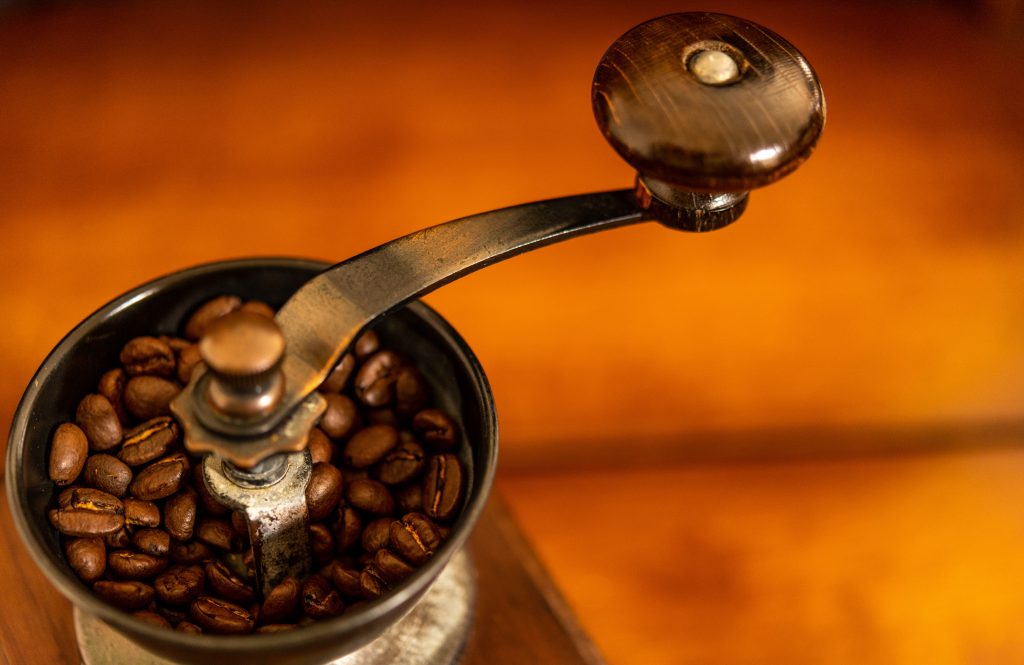
Burning coffee after it has been roasted to perfection? Why get complaints, often inexplicable, from customers, if you propose for sale always excellent blends of coffee ?
It was noted several times that overheating of the millstones “annealed” coffee; this is mainly due to the friction of the millstones themselves, if they do not work perfectly parallel between them, but also to the strong heat created with the rubbing and the resistance opposed by the same coffee, during its grinding.
In any electric grinder the heat that the millstones “milled” produces moved on beans, ricuocendoli as in a roaster to a 230 degree temperature regime, transforming significantly the coffee cooking same and with the carbonization of small particles irretrievably worse GUSTO , AROMA, COLOR!
A disaster that creates an acrid and unpleasant aftertaste, characteristic because it derived from bad grinding! Needless to explain the “lethal” effects to your customers !!!
BRAZIL
The classification methods of coffee are different and vary from one manufacturer to another country. The Brazilian classification could be called complete and standardized, but the same method can not be extended to other coffee producing countries, where the diversity of the plantations are significant and also spent a meager harvest does not allow the determination of a type medium or standards as Brazilian coffee.
Therefore, regardless of its source, the coffee is classified into several types according to the number of extrinsic defects due to the presence of impurities or foreign bodies, or intrinsic to the presence of grains damaged, brocate (attacked by insects) routes or only not well cleaned that it presents .
Therefore the greater or lesser percentage of defects that is contained in a batch of coffee taken into consideration, determines the classification of each quality in distinct types, which involve a different commercial value. They should therefore be considered in evaluating the many aspects rightly coffee.
In Brazil, the coffee can take the name from the port of embarkation where they are taken – or almost always – from the place name or the state in which they are produced. They are so valuable order: SANTOS – PARANA ‘- MINAS – BAHIA – Pernambuco – RIO – VITORIA.
With regard to coffee SANTOS , the most appreciated quality, we want to mention those from districts: Riberao PRETO (Mogiana), PINHAL, CAMPINAS, ARACUARA, MOCOCA, HIGH PAULISTA CAMBUHY, mostly described particularly sweet taste .
The dry processing method or wet out the coffee is natural and washed . Those natural have a non-uniform color and still retain a part of the silver film , the washed instead have a better appearance, more uniform color and the breast (central sulcus) of whitish color.
Even the shape of the grain is quite distinct; if coffee is flat grained it says FLAT BEAN, if the round grain is defined MIKA, Peaberry, Caracolito or PEARL. Both always originate from the same plant, if the grains have a round grain means that the fruit (cherry) that normally includes two flat bean beans by the action of solar rays that hit the cherries that grow to the extreme tips of the branches are ” abortion, “one of the two seeds by growing another round.
In the coffee trade of great importance is the selection of the grains according to size, ie, sieve (screen) that goes from the sieve 13 to the sieve 20 for flat bean and from the sieve 9 to 12 for the grits peaberry or pearl. However the coffee thickness or sieve can be established to “view” or with the mechanical selection Sifting and thus comparing the two systems have:
• VERY LARGE SCREEN BEAN – 20
• EXTRA LARGE BEAN – 19
• LARGE BEAN – 18
• BOLD BEAN – 17
• GOOD BEAN – 16
• MEDIUM BEAN – 15
• SMALL BEAN – 14/13
Example of typical description: “good to Lg bean or abbreviated GTlb” would correspond to a 16/18 sieve. Another typical description would be: SANTOS Criv. 18/17 ie to indicate that the mass of coffee contains 2/3 of sieve 18 and 1/3 Criv. 17. There are ways to express certain coffee thicknesses.
Even the coffee fibrous structure has its own terminology:
• STRICTLY SOFT (SS) = tender and sweet
• SOFT (S) = tender and sweet
• softish = tending to tender and sweet.
• HARD = harsh tough
• hardish = tending to hard or to sour.
Or the taste and aroma:
• MILD TASTE = sweet taste
• MILD TASTED = tried (tasted) Sweet
• MILD TASTED guaranted = guaranteed sweet taste
• GOOD TASTE = good taste
• CUP PROVED = tried in cup
• STRONG COFFEE = strong coffee
• ACID DRINK = sour drink
• FINE DRINK = drink order
• GOOD DRINK = good drink
• RIOLESS
• FREE FROM RIO = no taste of Rio
• EXCLUDED RIO FLAVOR
• SMOKELESS = no smoke flavor.
Also the color of coffee is indicated with different expressions and colors as GREEN LIGHT GREEN Greenish or are reported at the time of boarding connected to the coffee seasoning. Typically during the break in their home stores, forgiveness coffee color and yellow quickly to the effect of hot-wet “temperature” exists in Brazil, so that even when stored in very dry stores, the “yellow” or the “yellowish “but if they have absorbed moisture they become” light “or” lightsh “.
The color used to determine the finesse and structure fibrous and indicates whether the cafes were carefully prepared and if you still maintain abundant and essential aromatic oils. Therefore, anyone who buys a particular lot for partial deliveries has no right to complain if each delivery has different colors as the color is related to the degree of roasting – coffee may be more or less suited to roasting that is performed with special machines.
The presence of defective grains (green coffee beans) and “Quakers” (Quaker grits or undeveloped) is highlighted by roasting. In fact, these grains, which took place in roasting, not having the characteristic brown color of roasted coffee, but a much lighter color and undesirable taste.
Therefore the percentage of grains contained in a batch of roasted coffee is indicated by the following names:
– FINE ROAST : up to a maximum of ½% of clear grits;
– GOOD TO END ROAST : up to a maximum of 2% of clear grits.
– GOOD ROAST : up to a maximum of 5% of clear grits.
– GOOD TO FAIR ROAST, ROAST FAIR, POOR TO FAIR ROAST etc … : As you increase the percentage of clear grits.
HARVEST YEAR
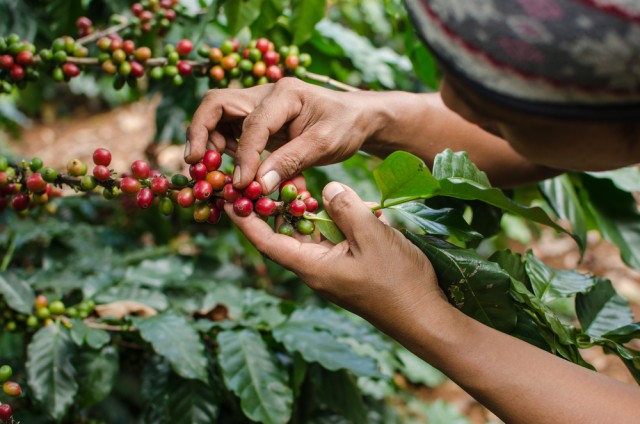
L ‘ indication of the year of harvest is particularly important, especially when you are on the home market to accumulate inventories of several years. In fact, as mentioned above, plus the coffee is old, but well maintained in dry areas, is gradually losing the essential and aromatic oils. In distinguishing the various crops, if the home seller or charger does not specify the crop year exactly, will be specified in the order the various crops under the following names:
– NEW CROP : new crop;
– CURRENT CROP : current harvest;
– PAST CROP : crop past;
– OLD CROP : old crop.
STANDINGS WITH THE METHOD OF NEW YORK COFFEE SUGAR EXCHANGE ABD
The classification longer in use in the United States and Brazil is that the method of the New York Coffee and Sugar Exchange which provides a numbered list of seven standard types, from NY2 to NY8. It ‘also in use for many decades, a ranking based on a name for the most part adopted by shippers in SANTOS and PARANAGUA’.
According to the method of the N EW YORK COFFEE ABD SUGAR EXCHANGE , the NY2 (the NY1 is not regarded as having no practical application because a coffee without defects does not exist) presents a coffee corresponding to the lowest percentage of defects, until arriving at the NY8 that It corresponds to a coffee with the highest percentage of defects. To compare the two methods:
• FANCY = Type 2 NY COFFEE
• EXTRA PRIME = 2/3
• RAW = 3/4
• SUPERIOR = 4/5
• GOOD = 5/6
• REGULAR = 6/7
• ORDINARY = 7/8
For exact description of the above types we have been prepared 2 tables, the first of which includes the equivalence of the various defects and imperfections that may be encountered in a batch of coffee on an average sample of 300gr., The second ranking of the corresponding types the number of established defects and calculated according to the table above, you get the classification according to the NY COFFEE etc.
It is intended for the exporting home charger origin who is often also a producer / exporter. The loader in classifying offered for sale coffee, also gives its name to coffee, for example: SANTOS FANCY NY2, type Goldy, Large Bean, Strictly Soft, Proved Cup, Fine Drink, Green. Shipper: JA Goldschmidt do Brasil or PARANA ‘PRIME NY3 / 4, type PRATA, Bourbon, orig.Londrina harvest 1968/69, criv.17 / 18, softish, Good Taste, Good to Fine Roast, green, Caric JA Goldschmidt do Brasil .
COLOMBIA
Colombia is located on the second place worldwide among the countries producing coffee and, therefore, the first among the Central American desserts such term in caffeicolo “Milds”.
The main production areas are located in the Andes region with the relative collection and processing centers that in order of importance are:
CALDAS – QUINDIO – ANTIOQUIA – CUNDINAMARCA – TOLIMA – VALLEY – SANTANDER – CAUCA – MAGDALENA – BOJCA – Narino – HUILA
It is worth mentioning, that with regard to this origin, the most popular types are imported from machining centers or collection : CALDAS (with machining MINIZALES, ARMENIA), ANTIOQUIA (MEDELIN). The cultivation of Colombian coffee is almost optimal conditions for the volcanic soil and the mild climate in an altitude between 1,400 and 2,000 meters above sea level.
The harvest for the particular geographical conditions of places of production, takes place 2-3 times per year . As for the cultivation of coffee this is taken care of by small family farms, which statistically represent 97% of total production, while the remaining 3% is led by very big farms.
The cafes are subjected – before being accepted by the collection centers – an inspection by experienced officials of FEDERACION NACIONAL DE DE COLOMBIA Coffee Growers, which will lay down the commercial characteristics .
STANDINGS AND TYPES
The Colombian Coffee hold up well any comparison with the best quality of coffee produced in the world, they have coarse-grained (of course depending on the types) of elongated shape, consisting of beans, a bit ‘rough and olive-green color.
Sometimes, as with the Brazilian origin coffee, the stock in the warehouses for the collection can transform the color of the grain toward the yellowish. The Colombian coffee in the cup has a taste and aroma “full-bodied”, intensely dye and, therefore, in relation to the roasters, it is of excellent performance in relation to the decline.
As I mentioned Colombian coffee named after the collection and processing centers rather than from the production area and then we will have the Medellin, Manizales, Armenia, Bogota, etc ….
In establishments runs the selection and cleaning process which consists in discarding with scrupulous attention defective grains, the lower ones and any impurities that can depreciate the value of coffee.
Sort thickness cafes are as follows:
• SUPREME = coarse-grained and without caracol (pearl type);
• EXCELSO = medium / short-grain that can hold Caracol.
An example: the Colombia Armenia Excelso is less like to a grain Colombia Medelin Supreme.
COSTA RICA
The cultivation of coffee in Costa Rica is the first among them. Its production takes place in the regions of the Altipiani Interandini of MESETA CENTRAL or CENTRAL PLATEAU OF TIERRAS TEMPLADAS.
The most important manufacturing districts are:
SAN JOSE ‘- CARTAGO – HEREIDA – harvested from October to March.
SAN JOSE ‘is the main market center of the Costa Rican coffee and most magazine (exporters) have their offices in this charming town which is well equipped for the processing of coffee.
The port of embarkation of the Costa Rican coffee grown in the districts overlooking the Atlantic Ocean is PUERTO LIMON, while for those facing the Pacific Ocean are boarded at PUNTA ARMOS or Golfito. The Costa Rica are good-looking coffee, coarse, blue green color. The cup has a full body and a very pleasant aroma earning it the reputation of CAFFE ‘PIU’ PURE WORLD.
STANDINGS
The coffees are distinguished according to the altitude and the ocean side, so those plants overlooking the Pacific Ocean side are so classified :
• SHB . = STRICTLY HARD BEAN, which are grown in heights from 1100 to 1350 meters from the level of amre.
• GHB . = GOOD HARD BEAN
• HB = HARD BEAN.
These two latest varieties that are grown from 900 to 1100 meters above sea level, GHB is better than HB because it is riddled and hand cleaner (trillado).
From the slope of the ‘ Atlantic Ocean they are classified:
• HGA = HIGH GROWN ATLANTIC grown from 800 to 1100 meters.
• LGA = LOW GROWN ATLANTIC grown from 600 to 800 meters.
ECUADOR
The cultivation of coffee has greatly developed since 1920 after the damage caused by various diseases to the plants of bananas and persimmons, so that alternatively, Ecuadorians have stepped up of coffee crops.
Several botanical varieties: Arabica TYPICAL, BOURBON, Caturra and ROBUST Canephora.
The cherry harvest the coffee takes place in June and August, by hand to fully mature ones, while at the end of the season and in bulk, all residues. The cherries are then dried in the sun, spread out “incementati floors”, using rakes, and piled in heaps to face the night.
The separation of the beans is carried out mechanically and also electronically with special sorting machines. The washing of the coffee takes place in the same companies where they are also cleaned and selected.
STANDINGS
Arabica washed in preparation for the European:
• SUPREME = manicured coffee sieve 18/19
• SELECTO = equally matched Coffee cared grits Criv. 17/18, very sweet and aromatic cup.
Natural Arabica:
• Caracolito = some small defect (blacks or broken)
• GALAPAGOS = very nice, Criv. 18
• A = 17/18 sieve and with some damage.
• EXTRA SUPERIOR = mixed grits: 18/17/16/15, some flaws.
Let’s leave the others lower ranking coffee as ESPECIAL, SELECTO, SUPERIOR, CORRIENTE of little interest, eg for domestic consumption used more.
The bags weigh kg. 69 net.
GUATEMALA
The coffee in Guatemala is grown on a large scale (30% of the population is active in this crop), but it should be considered that in the great “HACIENDAS” properties are belonging to Germans.
VARIETY ‘BOTANICAL:
ARABIC, BOURBON, Maragogype, typica.
STANDINGS
(Only for Washed Arabica coffee)
They are described according to the altitude of the production area, considering that more coffees are greater in height more the product is better:
• SHB = STRICTLY HARD BEAN from 1500 to 1700 meters in height;
• HB = HARD BEAN from 1350 to 1500 meters in height;
• If HB = SEMI HARD BEAN from 1200 to 1350 meters of height;
• EP = PRIME EXTRA from 1200 to 1000 meters of height.
The cafes Guatemala are particularly valuable and belong to the so-called “other sweets,” a designation typical of Central American coffees. It must therefore be considered that the use of such coffee, in particular those of high seas, 1500/1700 meters, in the preparation of the mixtures, to make a cup characteristic end taste. A mention to ANTIGUA GUATEMALA SHB PASTORES.
At the standings above, it follows the name of the producer. Coffee is so typified qualitatively . It should also be considered that even for this origin are produced both Maragogype that CARACOLITI. The bags weigh kg. 60 net. with a tare weight of gr. 700.
INDIA
The production of Indian coffee is constantly large increase, thanks al’adozione of rational and modern farming systems that improve quality performance. The production areas are in the south of India and in the states of: MYSORE, MADRAS, KERALLA. The Indian coffee in varieties Arabica and Robusta are prepared or processed:
• With “dry” system (dry) : in the dry process the berries are left to dry in the sun. Subsequently they passed through metal sieve to free them from impurities. So breaking machines special machines break the dry skin and release the grains that are then passed in other sieves where drafts eliminate remaining impurities. The process ends in separating machines that separate the grains according to the size.
• With wet “system for natural coffee”: in this method the berries, freshly harvested, they are placed in pits of cement traversed running water that free from impurities. The healthy berries, therefore, are placed on aie for desiccation, and, the next step to the breaking machines machines where they undergo the same procedure of the system “dry”.
• With a “wet system for washed coffee”:berries are placed on the staging tanks, and then pushed through channels of running water, in a pulper with a roller. The grains released from the pulp are still covered by its “parchment” on which there are residues, which can not be expelled by mechanical means, for which they are immersed 24/48 hours in large vats filled with agitators subjected to water movements. Here takes place the fermentation, which dissolves in water the residues of pulp and determines a chemical process, within individual grains (similar to what occurs in the fermentation of wine and beer). On completion of the fermentation, the beans are subjected to the actual washing in the purification tanks where strong clean coffee stirrers, until all traces of flesh disappears, and, It remains white and clean bone fiber which is carried outdoors on sieves of running water paths. The beans are then dried on aie or in mechanical driers and then placed on the separator where they are freed from any remaining impurities and separated depending on the size, with sieves of different caliber.
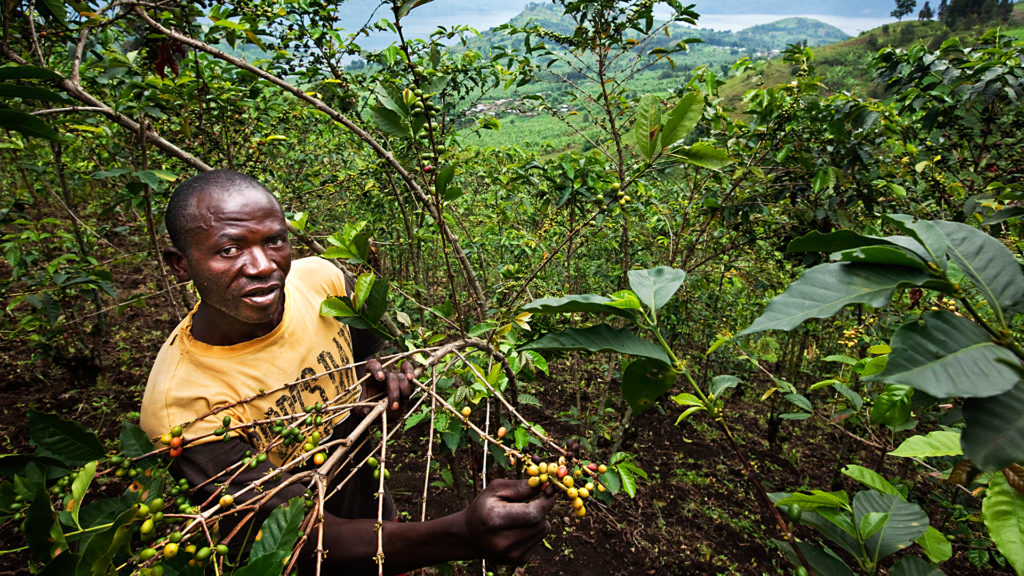
SPECIAL TERMS USED
• TRIAGE : grits broken, shriveled, spotted, elephants (or large grains deformed) discolored. Excluding black grits.
• FLATS : rounded grains but with flat side.
• BITA : measuring scrap less than one third of the grain.
• Peaberry : these coffee whose beans are completely round (pearl) almost two grains Berry who remained united.
• BLACKS : grits and more than half of their black surface or bluish or dark brown.
• BULK : Coffee unclassified.
The Indian coffee being processed very carefully, they are almost always consistent quality, taste of fine flavor, and are rightly considered among the best coffee produced in the world. All production of Indian coffee must be sold, the price of storage, Government Entity: COFFEE BOARD – Bangalore (India), which then determines the quantities and qualities to be destined for domestic consumption, and lots destined for export are sold all ‘auction with sealed envelope bids.
The port of departure CAFFE ‘: CEYLON, MANGALORE.
The Indian coffee is sold in double jute sacks net kg.60. the arrival on the European meracati takes place in November and beyond.
COFFEE VARIETY
• PLANTATION – are called washed arabica coffee.
• CHERRY – unwashed coffee arabica and robust.
• PARCHMENT – Robust washed coffee.
• Monsooned – both arabica coffee robust unwashed (are in demand coffee and specially prepared, in fact, are selected during the period of the monsoon, just before the end of May until mid-June). They are scattered in large paved areas and arranged in layers to absorb sufficient moisture, turning and turning the mass of the beans for about 1 week so as to make them swell.
These coffees are then stacked in department stores covered and well ventilated – to prevent formation of mold – bagged and rivuotati. Processing that lasts around two months, to ensure sufficient natural drying process that will make the white beans / yellowish, very good taste in the cup. The embarkation of these coffee takes place in September and arrives in European markets from late December onwards.
STANDINGS
The Arabica coffee Indians have a color of bluish / greenish, partially covered by a silver film, well elongated grains and plates. They are very sweet and highly aromatic:
• PLANTATION A – washed arabica, flat grain 85% minimum, retained by the sieve with round holes diamt. mm. 6.5 and not more than 1.5% must pass through a sieve with round holes of 6mm diameter. It is tolerated a triage of 3% and not more than 3% and not more than 2% of peaberry.
• PLANTATION B – washed arabica, flat grain the 75% minimum, retained by the sieve with round holes diamt. mm. 6 and not more than 1.5% must pass through a sieve with round holes of 5.5mm diameter. It is tolerated a triage of 3% and not more than 3% and not more than 2% of peaberry.
• PLANTATION PB – peaberry, or pearl, washed arabica beans flat shape grits (flats) not more than 2%. Tolerance of 3% triage peaberry.
CHERRY Indian Arabica coffee, are very strong in the cup, neutral, liqueur, and free of unpleasant taste. Preparation by the wet process of natural coffee; are considered so unwashed coffee, grits flat (flats), classified according to the size of the grains:
• ARABICA CHERRY FLATS – very coarse grained coffee.
• ARABICA CHERRY A – coarse coffee.
• ARABICA CHERRY B / C – medium and small coffee beans.
• Arabica Peaberry – pearl or caracolito.
It should be mentioned a special machining of Indian arabica coffee:
• MALABAR AA Monsooned
• MALABAR BB Monsooned
• BASANELLY Monsooned – The basanelly coffee are as immature grains and a little immature.
• Monsooned T.
INDONESIA
Land area, with GIAVA islands, SUMATRA, BORNEO SOUTH, CELEBES, MOLUCCAS and PROBE.
a coffee embarkation ports: SURABAJA, TANDIOENG, PALEMBANG, BENKULEN, Telukbetung, Sibolga, DELI, Belawan, PADANG, PRIOK, SEMARANG, Djakarta.
PRODUCTION AREAS
Coffee production in Indonesia is predominantly made up of the ROBUST type coffee, island of JAVA and in that of SUMATRA BALI. They grow in small quantities excellent European Coffee (Java, Bali, North Sumatra, Celebes) and it is believed that the quantity produced must not exceed 10% of the total production of Indonesian coffee.
TYPES AND CLASSIFICATION
The Indonesian coffee are divided into ROBUST (EK, natural; AP, washed) and ARABIC.
CAFFE ‘ROBUST:
• JAVA ROBUST – whose best quality is called WIB 1, or WIP (ie WEST INDIAN BEREIDING) 1 indicates first choice. They are also classified according to the size of the grains, for example, JAVA BEAN EXTRA LARGE, LARGE BEAN JAVA, JAVA MEDIUM BEAN , respectively grains very big, big, medium. The JAVA coffee are highly savory taste, liqueur, good roasting and very large grains that grow well during roasting. Mostly washed (washed). Recommended because suitable for the preparation of good coffee blends for bars.
• SUMATRA ROBUST – natural coffee that is classified according to grain size and defects. The taste of this coffee goes from good to fair and poor, neutral. Roasting poor with a high percentage of decline, because very wet coffee.
They are divided into:
– EK SPECIAL EXTRA LARGE BEAN = very big grain almost without flaws.
– EK SPECIAL = coarse, almost flawless.
– EK 1 3/5% = medium grain with 3/5% triage (waste).
– EK 2 6/8% = medium grain with 6/8% triage (waste).
– EK 2 8/10% = medium grain with 8/10% triage (waste).
– EK 3 10/12% = medium grain with 10/12% triage (waste).
– EK 3 10/15% = medium grain with 10/15% triage (waste).
A good part of the production of coffee SUMATRA ROBUST is started in Singapore where, in large local establishments, various companies subject the coffee to a washing process with hot water, drying and sanding with special centrifuges.
The beans become more developed, lighter weight, and after the “machinations” take on a yellowish / luminescent color. Rimessi commercially and exported under the name of MALESIA ROBUST and with the following charts in accordance with the defects of grain thickness. The taste is better than the natural EK, so the roasting is a smaller decline because more dry: AP SPECIAL = coarse-grained good and almost flawless.
– AP1 RUGGED 3/5% = medium grain with 3/5% triage
– AP2 ROBUST 10/15% = grained with triage in%
– AP2 ROBUST 20/25% = grained with triage in%
– AP3 ROBUST = grained and very small with 50% triage
For both SUMATRA MALAYSIA ROBUST ROBUST that the cafes: EK2-EK3-AP2 and AP3 for several years are not marketed for export, probably are used on site for the extraction of soluble coffee and freeze dried.
They are also exported to the BALI ROBUST , similar to Sumatra Robusta, natural grain, but more developed and better taste in the cup, always refers to the discrete level taste for these modest fine coffee.
A special mention goes to the coffee Mandheling ROBUST , good / fair cup, superior in taste to Sumatra and Bali, although smaller grains appear with various defects.
CAFFE ‘ARABICA :
mentioning the most popular, although they are not always available in the market:
– SUMATRA ARABIC Mandheling – coarse, heavy yellow / brownish color. Aroma and particularly pleasant taste, coffee liqueur (heavy body), poor roasting.
– SUMATRA ARABIC Ankola – medium grain, pleasant flavor, full-bodied.
– CELEBES ARABIC KALOSSI – coarse, good aroma and flavor liquorosità.
– CELEBES ARABIC Rantepao – medium grain, good aroma and flavor liquorosità.
JAVA ARABIC – cultivation in plantations run by Europeans, excellent quality coffee flavor fine and mellow, have become, unfortunately, rare coffee.
EXPORT PERIOD:
ROBUST from January to April, Arabica from December to March.
NICARAGUA
As for Guatemala coffee, they are described and classified according to the height of the crop above sea level and also according to the production area. The Matagalpa and JINOTEGA, coffee of the Northern Region and South MANAGUA, are the best known in European markets.
STANDINGS
– CENTRAL ESTRICTAMENTE HEIGHT = or SHG from 1500 to 2000 meters.
– CENTRAL HEIGHT = or HG from 1300 to 1500 meters.
– CENTRAL BUENO LAVADO = MG or from 1000 to 1300 meters.
– CENTRAL STANDARD = or LG 500 to 1000 meters.
They are marketed mostly “LAVADO” coffee to which the following names: WASHED NICARAGUA, WASHED Matagalpa, WASHED JINOTECA, and again for MARAGOJYPE (end washed, strictly high grown, JINOTECA or Matagalpa).
Weight kg bags. 69 net. Tara gr.600.
SAN DOMINGO
The origin of this coffee are at high qualitative level, the processing is done with the wet system thanks to the many modern plants for the benefit of the chin coffee.
The most important manufacturing districts are arranged as regards the northern regions of LA VEGA, SANTIAGO DE LOS CABALLEROS, PUERTO Plada, DUALTE and SALCIEDO.
For the southern districts: BARAHONA, AZUA, SAN CRISTOBAL, BANI and OCOA.
STANDINGS
The Dominican coffee most well-known in commerce, such as St. Domingo, are all washed, quality and relative merits vary according to the production zones. The beans are good-looking, coarse-grained dark gray color tending to blue and the infusion is intensely colored with aroma and fine flavor and full-bodied.
The most popular Dominican coffee are those deep sea classified as follows:
– CIBAO – production at Santiago, La Vega and Caballeros.
– OCOA – washed (in San Jose de Ocoa).
– BARAHONA – washed product in the southwest.
For coffee places on the market is also used to add the name of the magazine in addition to the production area, for example: San Domingo Barahona BB Toral, where Toral indicates the charger name.
The harvest takes place from October to March, and as far as this coming from Italy until a few years ago was the main consumer of all the European countries.
KENYA
The coffee production in Kenya is the most important activity of the country. The plantations mostly in European hands include vast territories, while the natives have limited extensions of plantations. There are many farms around well 300 thousand smallholders represented by over 150 thousand cooperatives.
The cultivation of coffee in intensive nature, also on 2 acres of land. Altogether are recorded in Kenya plantations 850 of which 300 to below 21 acres and 540 to over 21 acres of land.
It is cultivated mainly in the coffee areas of Kiambu, THIKA, Ruiru, MITUBIRI, Makuyu, DONYOU Sabuk, RIFT VALLEY, Nyeri, trans Nzoia in almost all heights ranging between 1,500 and 2,000 meters above the sea level.
The collected main takes place from October to March, while the working and the coffee selection is from June to January in the areas of Kiambu, Thika, Ruiru and from August to February in the west of the Rift Valley.
The bags are double Juta. Tara kg.2.2 kg.60 of coffee.
COFFEE DESCRIPTION AND RANKINGS
In the preparation of coffee KENYA forms the machining as for sweets Coffee COLOMBIAN . Before perfectly ripe berries are selected, those little or too mature are discarded. This process occurs before the stripping. They are eliminated all the skins in order to obtain a clean fermentation and then with a “wet” method (with the incision of the pulp, fermentation and washing in appropriate channels) the preparation and sorting processing establishments is performed.
Then comes the ‘ natural drying in the sun, with special care, so that all grains have a uniform color.
We would like to mention the establishment of KENYA COOPERATIVE UNION PLANTERS NAIROBI , whose remarkable proportions facility is the most modern existing now and help to increase the standard of the crop and therefore the classification. In these establishments you can work well 300 thousand bags of coffee.
E ‘should be remembered that coffee is paid to farmers on fixed prices and agreed unionized based on the quality assigned by the farmers who charge a certain percentage before the auction. In fact, all coffees are stored in NAIROBI throughout the year and are regularly held auctions, where they can participate only authorized by MILD COFFEE TRADE Assosiation who buy for their own account or for the principals overseas. The quantities of coffee auctioned, at least 40 sacks, are carefully classified and guaranteed by the certification which is the “KCMB = NAIROBI KENYA COFFEE AND MARKETING BOARD”.
CLASSIFICATION AND CRIVELLI
KENYA GRADE FAQ (Fair Average Quality = Good Quality Media)
KENYA UG (Under Kenya Grade = below average)
” AA ” = 18 sieve
” BB ” = 16 sieve
” C ” = sieve 14/15
” A ” = 17 sieve
” B ” = 15 sieve
” E ” = malformation by a pearl grain enclosed by a coarse grain sieve exceeding 20.
” PB ” = caracolito
” TT ” = small grains.
The classification is often accompanied by a more precise description for the quality in the cup as TOPO QUALITY, FINE QUALITY, VERY FINE QUALITY, QUALITY FAIR. I have a good Kenya coffee roasting, there is some clear grain, in the cup a fine coffee, liqueur, full-bodied and without any foreign flavor.

TANZANIA
The main production centers are in areas of Bukoba, MOSHI, ARUSHA, Tukuyu, MBOZI where you collect mostly Arabica coffee, limited quantities of Robusta. Certification body: Tanganyika COFFEE BOARD MOSHI.
STANDINGS
They adopted the same charts and selection of grits as for Kenya, because coffee is treated the same way, working with the same system and the harvest takes place at the same time, so no particular difference in the qualitative and commercial definition and descriptions.
UGANDA
L ‘ Uganda mainly produces “robust coffee type” whose cultivation is practiced both in small plantations of a few acres in extent than on vast territories of several hundred acres, of European farmers property. The most important area is to Mendo / Masaka in Buganda province, for Robusta.
The Uganda Coffee , mostly exported, are the natural type, yet washed, whose processing is steadily increasing, deserve wide consideration.
The type of “Arabica” Ugandan coffee is grown in the districts of Bugisu, Mendo, Toro, Ankole, Kigesi and also in Masaka; it is a highly valued quality in world markets.
– Flowering period : from April to June.
– Harvest time : from November to February.
The bulk of the crop is placed on the market from September to March.
BUSINESS
All the coffee exported is subjected to the control of CMB THE UGANDA (THE COFFEE MARKETING BOARD UGANDA) based in Kampala, which is the certification body.
This government agency fixed producer prices, regardless of the global market situation, and monitors the standard of coffee exports, taking a sample of samples and approving or not the quality before authorizing the marking of the bags.
Ports of Mombasa, Dar es Salaam, Tanga, Atiak, Nairobi. Jute sacks in double – kg.2200 tare.
CLASSIFICATION
– UGANDA ROBUST n.5 or IMPALA (SUPERIEUR BIG) – minimum 18 sieve treated and cleaned dry, good-looking grains in relation to the gradation (comprises from grade 1 to 5) with no trace of mold, without skins or foreign material , it does not contain more than 5% of defective grains: this figure includes not more than 1% of blacks and shell beads.
– UGANDA ROBUST STANDARD GRADE 10 – treaty or dry-cleaned, satisfactory grains good appearance in relation to the content (including the degree 0-10) without mold trace, does not contain more than 10% of defective grains that include no more 2% of blacks grains and not more than 1% of coffee not shelled and also there will be no more than a 10%, by weight of extraneous materials.
– UGANDA ROBUST STANDARD GRADE 20 – treaty or dry-cleaned, satisfactory grains look good in relation to alcohol content (Includes 11 to 20) without any trace of mold, does not contain more than 20% of defective grains that include no more 1% of coffee not shelled, not more than 5% of empty grains and also there will be no more than 0.5% by weight of extraneous matter nor more than 2.5% by weight of the skins.
– UGANDA ROBUST FAQ – good year average, unselected non-riddled – treated or cleaned dry, with no trace of mold, does not contain, depending on the alcohol content, more than 25 or 50% of defective grains that include no more, respectively 1 or 2% of non-shelled coffee and also there will be no more than 0.5% by weight of extraneous materials, they respectively more than 3% or 5% by weight of the skins.
– UGANDA ROBUSTAHAND-PICKING and TRIAGE (broken and residues) – dry, equal to the sample approved by the CMB Uganda, from time to time.
– WASHED ROBUST or CRANE minimum criv.18, depellicolati.
– WASHED ROBUST STANDARD sieve 15.
To GRAINS BLACKS means completely blacks beans inside and outside.
To GRAINS BAD means the beans blacks partially or abnormally dark or discolored or damaged by insects or punched or folded, or crushed. A grain shattered means broken into smaller pieces by half.
For coffee TREATY or CLEAN DRY (DRY COFFEE) means the dry coffee whose moisture content is not more than 12.5% ie that does not lose additional weight when it is left in an oven for 24 hours at a temperature of 100 degrees.
UGANDA ARABICA- ARABIC DRY PROCESS
Variety classified into two grades: 10e 20, both described as “buckets” clean and of good appearance. The grains green / blue color for the most part covered with silvery film, are rather large and elongated, Criv 18/19, good flavor, liqueur, sweet taste but little aromatic.
– GRADE 10 = no foreign matter, maximum defect allowed no more than 10% including 15 blacks or beans in shell and not more than 2% of robusta coffee.
– GRADE 20 = maximum defects allowed no more than 20% including not more than 10% of the foreign bodies 2% of blacks beans, 1% of beans in shell and not more than 4% of robusta coffee.
– TRIAGE = waste, but are dry coffee and clean and still equal to “type” specimen approved by the CMB UGANDA.
UGANDA ARABICA pulped AND WASHED
Variety classified into 4 degrees: 5, 10,15 and triage. Described as a “dry” clean and of good appearance, without Robusta coffee beans.
PW GRADE 5 = no blacks beans, shell shells or grains, without foreign matter, defects maximum 5%.
PW GRADE 10 = no blacks, no shells or shelled beans, up 10% defects.
PW GRADE 15 = maximum permitted defects 15% including 1% blacks beans, 1% gani shells or shell, 1% of foreign matter.
TRIAGE = “dried coffee” equal to “type” specimen approved by the CMB.
ZAIRE ROBUST
The most important production of coffee STRONG Zaire, is made in the Equator and Oriental provinces. Most crops extend in the lowlands of these provinces both for a more qualitative than quantitative yield.
Much appreciated the production of UELEH district to the northeast, in the Equator province.
Flowering period : from April to May.
Harvest time : from June to July, however, in the Equator province collects almost all year round and mostly in the months of December, January, February.
Port of departure : KINSHASA.
Tara: gunny bags gr.700, gross weight of coffee in bags around kg.60,500.
CLASSIFICATION
In the robusta coffee typing takes into account all the various aspects of quality, it is also carried out a rigorous control by a Governmental Authority Zairoese: ONC ie OFFICE NATIONAL DU CAFE ‘Kinshasa. The ONC issue a certificate attesting to the quality and type classified if the coffee is either the standard type of classification for the various aspects, such as the state of raw, try roasting, taste in cup and if framed in exportable types for sale autorizzatat it is the marking of the bags.
CLASSIFICATION STANDARD
Robusta coffee Zaire, are sold in 6 different types, both as regards the thickness of the grains, which are estimated at sight:
– M = MOYEN (mean thickness, sieve 17)
– I = INFERIOR (less than 17 sieve)
both as regards the treatment of the coffee can be:
– W = WASHED (washed)
– N = NATURAL (natural)
both for the quality of coffee that can be:
– HTM (Hors Type Marchand) = higher quality.
– HTC (Hors Type Courant) = current quality.
Here are the markings on the bags of coffee:
ZAIRE ROBUST
– HTM / N / M = superior quality, natural and of average grain thickness criv.17
– HTM / W / M = equal to the previous, however, washed.
– HTM / N / I = superior quality, natural and grains less than criv.17.
– HTM / W / I = same as above, however, washed.
– HTC / M = Current quality, with triage (with blacks beans and various scrap) of mixed grain size: small, medium and large.
– HTC / I = current quality, with triage as above but of smaller grains.
It is worth mentioning that is prohibited from being exported Zaire of any batch of coffee which has: musty odor of rotten taste or odor and foreign substances of any nature, with not more than 5% of such particles and with humidity of not over 12%.
And ‘prudent to examine these coffee with every attention, not exceeding in defects that often consist bad fermentation of grains or because crops prematurely or because during the harvest suffered rains, making rot a good part of the berries, so they will give a flavor of leather (stinker).
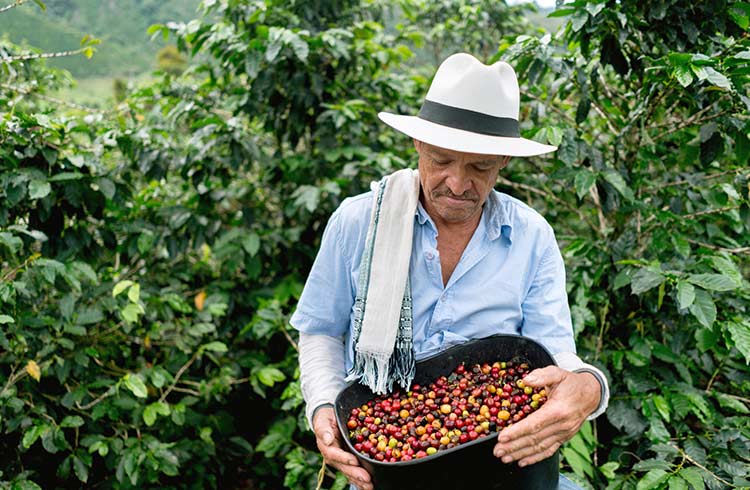
TOGO
The cultivation of coffee TOGO, in 50000 hectares, held by small family businesses, or grouped in cooperatives.
VARIETY ‘BOTANICAL: NIAOULI ROBUST and ROBUST CANEPHORA
The coffee is harvested from December to February.
The treatment is dry . A curiosity: the drying and husking the coffee is made by the manufacturer on site by means of itinerant workers, paid in cafes, on the basis of 15% of the harvest done.
The TOGO coffee, qualitatively, have the beans often buggy , a neutral taste while roasting is delicate rather uniform, determining motive in using such coffee for the production of soluble.
STANDINGS
EXTRA FIRST, BEFORE, UPPER, and also COIRANT TRIAGE.
The sieves are distinguished in:
– GRADE I = CRIV.16 / 18
– GRADE II = 14/16
– GRADE III = lower than 14.
Weight of net kg.60 bags plus a tare weight of 1 kg.
Export Port: LOME ‘.
MADAGASCAR
Most of the land under coffee cultivation, approximately 95% are owned by small companies often cooperative character.
BOTANICAL SPECIES: STRONG, Arabica.
Robusta coffees are also called Kouilou.
STANDINGS
– FIRST EXTRA (maximum 15 defects, including 5 blacks grains)
– RAW (maximum 30 defects, including 10 blacks grains)
– HIGHER (maximum 60 defects, of which 15 blacks grains)
– COURANT (maximum 120 defects)
Most of coffee are depellicolati and clean, but a small part is washed.
It takes into account the selections depending on the size of the grains, setting them in grade:
GRADE 1 = criv.18 / 20 oppre 16/20 or 16/18
GRADE 2 = criv.14 / 16
GRADE 3 = criv.12 / 14.
Description typical example: MADAGASCAR ROBUST Kouilou, GRADE 1, sieve 16/18, EXTRA PRIME, Lave, depelliculè et wiped.
CAMEROON
In Cameroon, as in the Republic of Côte d’Ivoire, there has been a steady increase in coffee production, respectively, in the two cultivated species:
ARABIC = poor coffee but valuable production;
ROBUST = a variety considerably from harvest.
Harvest in the month of November to February.
DISTRICTS OF PRODUCTION
The manufacturing districts are located between the regions washed by rivers Nyong, Sagana and Mbam which refer to the NDIKINIMEKI collection center. In these areas the crops are of little importance among the wet regions by Boumba rivers, Ngoko, Lom and Kadei that are part of another assembly center Lomie ‘where you have mixed crops to those of cocoa, and are grown is coffee Arabica Robusta .
In regions Mbanga, Bafang that go the big center of DOUALA collection, which is also the most important port for coffee. In these latter regions are the most important crops of Robusta coffee, virtually the bulk of production, this is due to the particular characteristics of the environmental conditions, fertile soils at medium altitude, heavy rains, especially a high constant humidity.
STANDINGS
The coffee Cameroon presents with very large grains , precisely because of the high percentage of humidity which contain, in the roasting have a relatively higher than the average weight decrease, however, are obtained by well-developed grains and the brew in the cup is much liqueur and appreciable flavor.
The Robusta coffee are classified into: HIGHER, COURANT, LIMIT.
Tele jute from gr.700 kg.1 according to the charger.
– SUPERIEUR – generally homogeneous color grains on greenish / brownish, the thickness of the grains is commercially described: criv.16 / 18 and 18/20. FAULTS: no more than 60 on a 300 g sample.
– COURANT – uneven color brownish grains, broken in a minimum percentage. FAULTS: no more than 100 on a 300g sample.
CAMEROON ARABIC
The species is a variety of Arabica coffee and much appreciated in continuous increase of production, if it draws a very full-bodied and aromatic infused, therefore suitable for blends.
STANDINGS
– EXTRA PRIME (there is also the UPPER COURANT and of little interest, for the European market)
– EXTRA PRIME AA (washed) contains 70% over the criv.19 and 30% criv.18
– EXTRA PRIME A (washed) contains 70% over the criv.18 and 30% criv.17
– EXTRA PRIME B (washed) contains 70% over the criv.16 and 30% criv.15
– EXTRA PRIME C (washed) all peaberry or caracolito.
– LIMIT (or TRIAGE) mixed grains both for color and for thickness with a high percentage of broken, blacks beans, dried cherries, twigs, shells, pebbles. FAULTS: no more than 240 on a 300 g sample.
In order to accurately assess the ranking to be taken from a 300 g sample on the left, possibly, various bags, the faults according to the table are then separated following:
DEFECTS
1 grain damaged or dry-moldy or green color, reddish 2
1 black grained or even half black 1
1 cherry, dried fruit comprising its casing 1
2 impergamenate grits, if coated from pergamino 1
2 grits seminere, ie for less than half of black 1
5 grits white-spongy, gray-whitish opalescent and light weight 1
5 unripe green grains (dark green grits) 1
3 shells 1
5 Rottini, ie pieces of grits 1
5 grits so-called dry, ie dried on the plant without reaching full maturity 1
5 undesirable grits (botched or altered, imperfect) 1
2 rugged grits (grits of brown color that emanate open acid smell) 1
10 grits gnawed by scolite (grits roses from insects) 1
1 pergamino large (outer casing of the grain) 1
3 1 small parchment
1 large piece of wood 2
1 medium piece of wood 1
3 small pieces of wood 1
The stones are not considered a defect if a 300 g sample does not exceed gr.1.25.
ETHIOPIA
